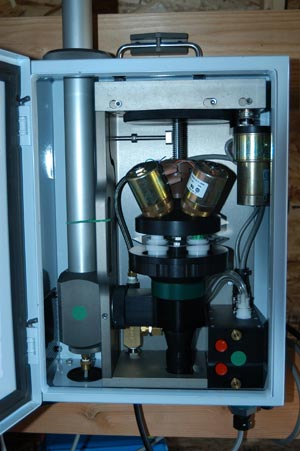Crocker Nuclear Laboratory highlights, 1939-present
- 1939 Ernest Lawrence and colleagues at UC Berkeley begin using their new 60-inch cyclotron, the largest and most powerful particle accelerator built to date. The same year, Lawrence wins the Nobel Prize in physics. http://www.lbl.gov/Publications/75th/files/04-lab-history-pt-1.html
- 1964-1966 Crocker Nuclear Laboratory is established at UC Davis with the arrival of key components from the Berkeley cyclotron, including its 220-ton magnets. Members of the physics department modify the equipment and build a much larger 74-inch sector-focusing cyclotron, using 10-foot thick, 30-ton blocks of concrete for radiation shielding.
- 1966 UC Davis establishes Crocker Nuclear Laboratory, designating it as a separate administrative unit to highlight its utility to the entire campus. Physics professor John Jungerman is appointed director.
- April 1966 UC Davis physicists bombard a penny with the first beam of protons produced by the cyclotron.
- 1966-1972 Early work at CNL focuses on fundamental nuclear physics, including internationally recognized work on neutrons, alpha particles and gamma rays.
- 1971 The Atomic Energy Commission abruptly cuts off funding to CNL and many other nuclear facilities around the country. CNL survives by finding new applications for cyclotron science in areas such as air quality, testing of historical documents, food safety and cancer treatment.
- 1970s CNL’s second director, Thomas Cahill, uses the cyclotron to make accurate measurements of the composition of airborne dust. With grants from CalTrans and the state Air Resources Board, CNL researchers show that wind and local conditions can send lead pollution from a freeway over local neighborhoods. CNL’s work backs up tough new air quality standards imposed by Governor Jerry Brown, including requiring the removal of lead from gasoline.
- 1979 Funded by the EPA, CNL staff design and install 40 airborne particulate matter sampling stations in eight states.
1983 CNL research chemist Manuel Lagunas-Solar and colleagues

Artist's concept of NASA's Orbiting Carbon Observatory, set to launch in 2014, and one of three managed by Jet Propulsion Laboratory. Credit: NASA/JPL-Caltech develop the first method for making pure iodine-123 used for thyroid imaging and to detect tumors.
- 1985 In 1985, the EPA taps CNL to oversee operations of a new program to monitor haze-producing fine particles in the nation’s national parks and wilderness areas. Over the decades, CNL researchers and staff design, deploy and monitor aerosol sampling stations at some 170 sites in the U.S., Canada and Korea.
- 1980s Thomas Cahill, UC Davis history professor Richard Schwab and other colleagues develop methods to use the cyclotron’s proton beam to produce precise and non-destructive analyses of the chemistry of ink and paper. Their research program, the Crocker Historical and Archeological Project, provides remarkable new information and insight about such historical documents as the Gutenberg bibles, Dead Sea scrolls, J. S. Bach’s family bible, and the controversial and arguably forged document known as the Vinland Map.
- 1990s Manuel Lagunas-Solar and colleagues study the effects of radio frequency treatment on more than 100 foods, finding that treatment of some foods, such as nuts and seeds, can destroy microbes and other pests without affecting quality.
- 1992 CNL scientists design and build an x-ray fluorescence (XRF) instrument for elemental analysis of IMPROVE aerosol samples. This new instrument achieves detection limits that are superior to those obtained with the cyclotron-based analysis previously used.
- 1994 CNL and UCSF initiate a collaboration to use the cyclotron’s focused beam of protons to treat ocular melanoma, a rare cancer of the eye.
- 1999 CNL scientists redesign the IMPROVE aerosol sampler, adding continuous recording of the sampler flowrate.
- 2000 The IMPROVE aerosol monitoring program begins expansion from about 50 sites to its current size of about 170 sites. The expansion is designed to support data analysis for the Federal Regional Haze Rule.
- 2003 For the first time collocated samplers are added to the IMPROVE network at selected sites. The data from these samplers are used to better quantify and understand the precision of the IMPROVE data.
2007 Work begins on a new aerosol generation chamber that allows the

This weather-resistant and versatile
aerosol sampler is the result of decades of design research and field testing by CNL's air quality team. Credit: Crocker Nuclear Lab staffpreparation of improved calibration standards for X-ray fluorescence (XRF) analysis of airborne particulate matter, providing air pollution researchers and monitors with an important new tool for measuring and analyzing the minute particles that cause air pollution.
- 2009 CNL scientists begin development of a new Fourier Transform Infrared (FT-IR) analysis technique for measuring carbon particles collected on IMPROVE aerosol filters. Compared to existing carbon analytical methods, this new FT-IR technique provides enhanced information at a lower price.
- 2011 Equipment for a new NASA mission is tested at CNL, taking advantage of the cyclotron’s unique capacity to be tuned to simulate the solar particles emitted by the sun and captured by the earth’s Van Allen belts.
- 2012 NASA deploys the equipment in its Van Allen Probes mission to study the radiation belts surrounding Earth.
- 2013 CNL’s proton beam is used to treat patient number 1,600 for ocular melanoma.
- 2013 Jose Mojica, head of CNL’s field operations for the IMPROVE program travels to South Korea to install an aerosol sampler on Baengnyeong Island on the maritime border with North Korea. The sampler will be used to measure airborne particulate matter drifting in from China.
